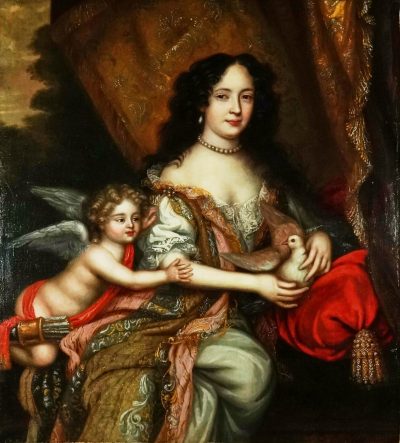Bellmans to sell portrait of Mistress of Charles II of England

A portrait of Louise Renée de Penancoët de Kéroualle, Duchess of Portsmouth (5 September 1649 – 14 November 1734) attributed to Henri Gascars (French, 1635-1701) as featured in The Daily Telegraph, is included in Bellmans' Old Master, British & European Paintings auction on the 12th October 2021.
The oil on canvas measures 107 x 97 cm and shows the Duchess with a Cupid. It was originally in a private collection in Gloucestershire from circa 1800 before it was sold by Lane Fine Art to the father of the present owner. It is estimated at £8,000 - £12,000.
The Duchess has been painted by many established artists, including Sir Peter Lely and several times by Gascars. She famously accompanied Henrietta Anne Stuart, Duchess of Orléans, sister of Charles II of Great Britain, and sister-in-law of Louis XIV of France, when Henrietta visited her brother in Dover in 1670. Henrietta's sudden death meant Louise was unprovided for and Charles II appointed her a lady-in-waiting to his own Queen, Catherine of Braganza.
Louise, born into a noble family at the Château de Kéroualle, near Brest, was introduced early to the French royal household in the hope that she may become one of Louis XIV's mistresses. Rumour had it that the French court may have selected Louise to fascinate Charles II, but there seems to be no evidence of that. When Charles did show favour, however, the French ambassador, Colbert de Croissy, and the secretary of state Henry Bennet, 1st Earl of Arlington, and his wife, supported her becoming his mistress. There is no doubt that the French envoy was keen for her to serve the interests of her native sovereign and Louise seemed to have done exactly that and as a result was showered with gifts and honours by Louis XIV, including being given a pair of earrings worth an astonishing £18,000, more than he ever gave to Charles' Queen. Charles II in return was taken by her childlike beauty and once she had a hold of him, her great cleverness and strong will. Louise was careful to show the Queen every respect and their relationship was always amicable and so it may not be a surprise that her son Charles (1672-1723) was created Duke of Richmond in 1675.
In 1673, she was granted the titles Baroness Petersfield, Countess of Fareham and Duchess of Portsmouth for life. These came with a pension and allowances and in 1681 alone she received £136,000.
Charles II also requested her inclusion in the Peerage of France and she became the Duchess of Aubigny in 1673. Although disliked by the people in England and Charles' other mistress Nell Gwynne, she retained her hold on him to the end and was instrumental in helping Charles II she retained her hold on him to the end and was instrumental in helping Charles II find a solution to the longitude problem, which ultimately resulted in the establishment of the Royal Observatory in Greenwich. Charles called her affectionately 'Fubbs', due to her being a little chubby, which was very much en vogue at the time, and in 1682 the royal yacht HMY Fubbs was named in her honour. In 1685, she ensured that Charles II was received into the Catholic Church on his deathbed and Louise was certainly one of three women in his life, along with the Queen and Nell Gwynne.
The Duchess of Portland also seems to have asked the French painter Henri Gascars (or Gascar/ Gascard) to come to England and paint her and other members of the King's circle. Born in 1635, he came to England in 1674 and although already known as a skilful portrait-painter, he achieved artistic success in England under the patronage of the Duchess. He painted many of the mistresses in his flamboyant style. His portrait of James II as Duke of York was in that king's famous collection. Around 1680 he left London for Paris before relocating to Rome, where he died in
1701.
Louise retired to France shortly after Charles' death, having fallen out of favour, and only returned to England twice, the last time for the coronation of George I. Although she ran out of money, the French King and Regent ensured that she had a pension and protected her against creditors. Louise died in Paris at the age of 85 in 1734.






